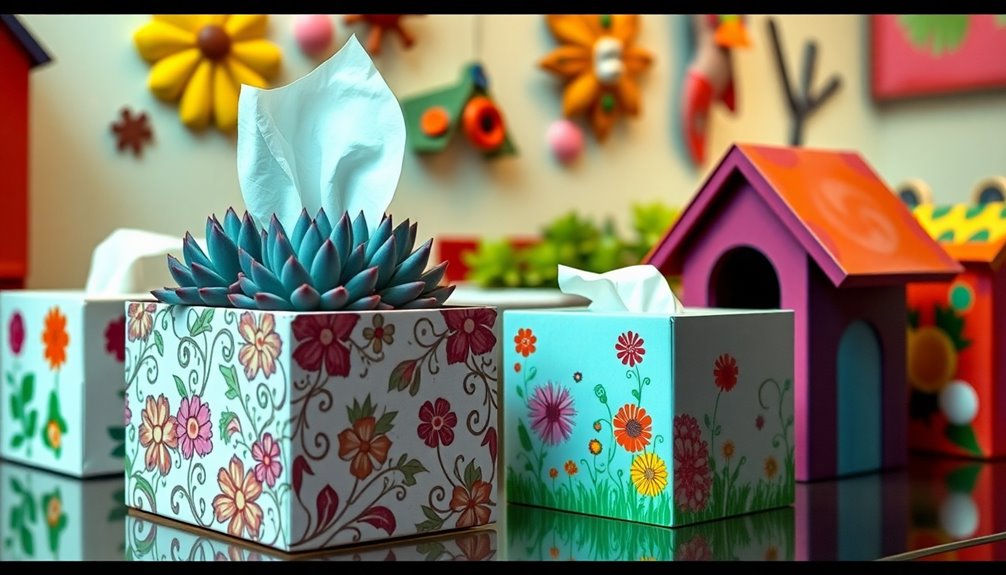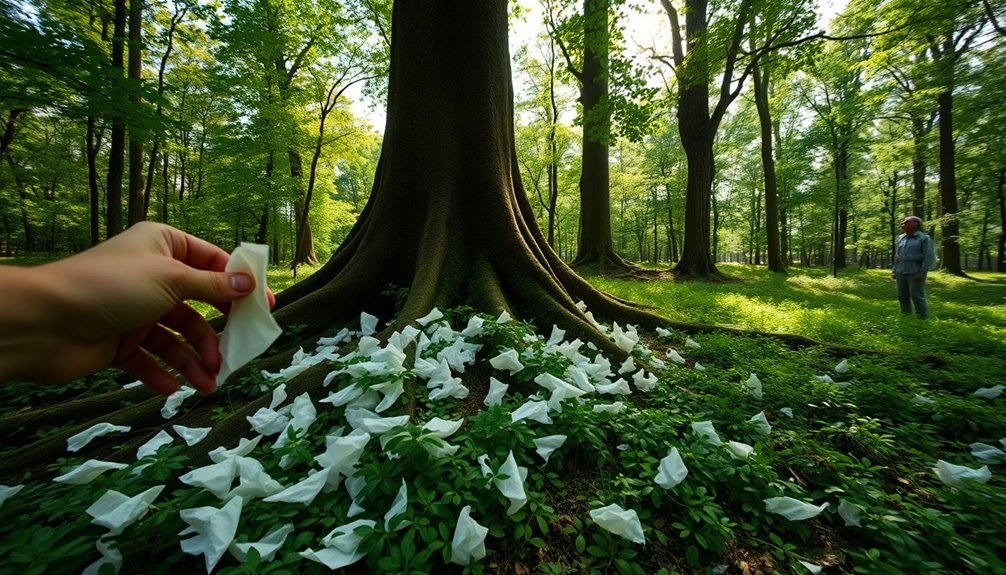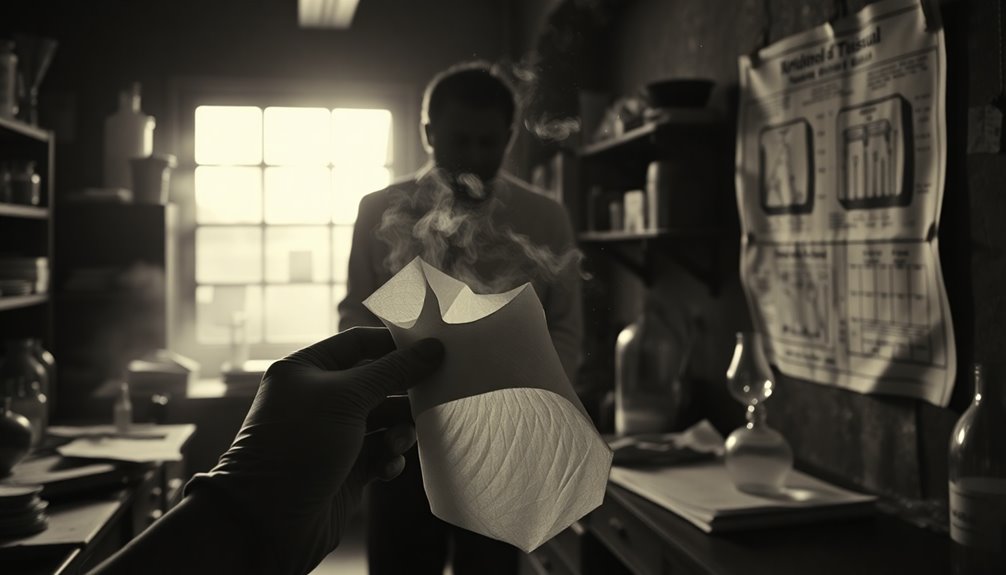You might be surprised to learn that Kleenex was invented by Kimberly-Clark in 1924, originally as a cold cream remover. The product aimed to appeal to women's beauty routines. By 1927, it was cleverly repositioned as a hygienic disposable handkerchief. With its unique pop-up box design introduced in 1928, Kleenex quickly became a household staple. The concept stemmed from World War I gas mask materials, showcasing innovation in hygiene. Today, it dominates the U.S. tissue market with over 50% share. There's more fascinating history and impact surrounding this iconic brand, so keep exploring to uncover the full story.
Key Takeaways
- Kleenex was launched in 1924 by Kimberly-Clark, originally as a cold cream remover for women.
- The brand name "Kleenex" is a combination of "clean" and "Kotex," linking it to the company's other product.
- It was repositioned in 1927 as disposable handkerchiefs, meeting a growing demand for hygiene.
- The unique pop-up box design introduced in 1928 contributed significantly to its popularity and convenience.
- Kleenex's success transformed personal care routines, giving it over 50% of the U.S. facial tissue market today.
Kleenex's 1924 Market Debut

When Kleenex hit the market in 1924, it was initially marketed as a product for removing cold cream, targeting women who sought a convenient solution for their beauty routines. The brand name "Kleenex" itself blended "clean" with "Kotex," reflecting its aim to provide a hygienic option for makeup removal. By 1927, the company repositioned Kleenex as disposable handkerchiefs, capitalizing on the growing demand for hygiene and convenience.
This shift proved pivotal. You began to see Kleenex not just as a beauty product but as an essential item for personal care. The introduction of a unique pop-up box design in 1928 further enhanced its appeal, allowing you to access the facial tissues easily with one hand. It matched perfectly with the bustling lifestyles of the late 1920s, making it a staple in households.
Before long, Kleenex became synonymous with disposable tissues, establishing itself as a household name. Its market debut transformed everyday hygiene and beauty routines, making it an indispensable part of daily life. As you reflect on this evolution, it's clear that Kleenex paved the way for modern personal care products we often take for granted today.
Origins of Disposable Tissues

Tracing back the origins of disposable tissues reveals an interesting journey rooted in necessity and innovation. Initially, the crepe paper used in gas masks during World War I laid the groundwork for what would become the first disposable tissues. In the early 1920s, Kimberly-Clark adapted this material to create Kotex for menstrual needs. By 1924, they introduced the Kleenex brand, initially marketed as a cold cream remover.
However, it wasn't until 1927 that the repositioning of Kleenex as a disposable handkerchief took shape, responding to consumer demand for a more hygienic alternative to cloth handkerchiefs. This shift established disposable tissues as a household staple. The introduction of the unique pop-up box design in 1928 significantly enhanced user experience, allowing for easy, one-handed access to tissues made for facial use. Over time, this paper innovation solidified Kleenex's status, especially during cold and allergy seasons, as people sought convenient solutions to combat the common cold.
Today, Kleenex holds over 50% of the market share in the U.S. facial tissue market, reflecting its enduring appeal and successful marketing strategies.
Creative Tissue Box Repurposing

Empty Kleenex tissue boxes have become a canvas for creativity, inspiring countless DIY projects and innovative storage solutions. You can easily repurpose these boxes to organize various items around your home, like craft supplies, toys, or even remote controls. The unique pop-up design introduced in 1928 not only made accessing tissues convenient but also transformed these boxes into practical desktop organizers or charming gift boxes. Additionally, utilizing sustainable practices in your DIY projects can contribute to environmental benefits. Engaging in hands-on activities like these can also enhance fine motor skills in children, making it a perfect family project. Furthermore, using native plants in your home garden can foster a connection to nature, complementing your creative endeavors.
If you're feeling crafty, consider turning an empty tissue box into a decorative home accent. Cover it with fabric or paper to create a personalized art piece that adds flair to your space. This is a fun DIY project you can enjoy with your kids, fostering creativity while teaching them about recycling and reusing materials.
Thanks to the versatility of Kleenex boxes, online communities have flourished, sharing innovative repurposing ideas that promote sustainable living. You'll find a treasure trove of creative suggestions that inspire you to make the most of what you already have. Additionally, engaging in creative projects can help enhance cognitive function and improve your overall mood. So, grab those empty tissue boxes and let your imagination run wild as you explore the world of repurposing!
Environmental Impact of Disposal

Disposable tissues, like Kleenex, pose significant environmental challenges, contributing to over 300,000 tons of waste in the U.S. each year. The majority of Kleenex tissues are made from virgin wood pulp, raising serious environmental concerns regarding deforestation and its negative impact on biodiversity and carbon sequestration. While you might appreciate the convenience of single-use products, it's crucial to recognize the environmental cost that comes with these disposable tissues, including increased landfill contributions and resource depletion.
Kimberly-Clark, the parent company of Kleenex, is striving for change. They've committed to sustainable sourcing, aiming for 100% of their fiber supply to come from certified, sustainable forests by 2025. However, even with these efforts, the environmental footprint of disposable tissues remains significant.
Recycling initiatives could help mitigate some of these effects, but tissue products are typically not recyclable due to contamination from bodily fluids and other materials. As you consider your tissue usage, think about the broader implications of your choices and explore more sustainable alternatives that could lessen your impact on the environment.
Consumer Usage Trends Over Decades

Over the decades, consumer habits surrounding Kleenex have evolved significantly, reflecting changing lifestyles and health awareness. In the 1930s, you'd find Kleenex gaining traction as disposable handkerchiefs, thanks to consumer feedback that highlighted its hygienic benefits during cold and flu seasons. By the 1950s, Hollywood stars began endorsing Kleenex for makeup removal, further embedding it into daily routines and boosting Kleenex sales.
Innovative packaging designs, like the Space-Saver box launched in 1961 and Kleenex Juniors in 1964, catered to your need for convenience and portability. Fast forward to the 2000s, and the introduction of Anti-Viral tissues, boasting a 99.9% virus kill rate, showcased a growing trend toward functional products that address health concerns.
Today, Kleenex holds over a 50% share of the US facial tissue market, a testament to its enduring presence and consumer preference. These usage trends illustrate how Kleenex has not only met your practical needs but has also adapted to lifestyle changes, ensuring it remains a staple in your personal care arsenal.
Kleenex's Surprising Inventor Revealed

Have you ever wondered who was behind the creation of Kleenex? The surprising inventor is Ernest Mer, the head of research at Kimberly-Clark. Mer developed this innovative product from Cellucotton, a material originally used in gas masks during World War I. In 1924, Kleenex was first marketed as a cold cream remover, cleverly branded by combining "clean" with "Kotex" to target women for makeup removal.
Its initial purpose quickly evolved. By 1927, Kleenex was repositioned as disposable handkerchiefs, which solidified its place in the market. The unique pop-up box design introduced in 1928 was a direct response to consumer feedback, making it easier for you to grab a tissue with one hand. This adaptation not only improved usability but also catered to the needs of a growing customer base.
Frequently Asked Questions
Why Is Kleenex Banned in Canada?
Kleenex isn't actually banned in Canada, but certain regulations do affect its sale. You might find restrictions on tissues with harmful additives in some provinces, aimed at protecting both consumers and the environment. As a result, Kleenex has had to adapt its formulations to meet these local laws and consumer demand for eco-friendly products. While you can still find Kleenex, its offerings may look different than what you're used to.
Who Invented the Kleenex?
You might be surprised to learn that Kleenex was invented by Kimberly-Clark in the early 1920s. Initially created for removing cold cream, it quickly gained popularity for its convenience as a disposable handkerchief. Ernest Mer played a key role in its development, and consumer feedback helped shape its use. By the late 1930s, Kleenex became a household name, transforming how people approached hygiene and convenience in everyday life.
Why Is Kleenex Bad for the Environment?
Kleenex is harmful to the environment for several reasons. First, its production often leads to deforestation, contributing to habitat loss. You should also consider that making disposable tissues releases significant carbon emissions. Plus, using them creates a lot of landfill waste since they're single-use and take years to decompose. While some brands offer recycled options, most Kleenex products don't, limiting their sustainability and increasing their overall environmental impact.
Did Kleenex Lose Its Trademark?
Yes, Kleenex has faced challenges in maintaining its trademark. As the term became synonymous with facial tissues, it risked losing distinctiveness, similar to other brands like Xerox. To combat this, Kimberly-Clark has actively educated consumers on using "Kleenex brand tissues" instead of just "Kleenex." By doing this, they aim to preserve the brand's identity and legal protection, ensuring it doesn't become just another generic term in the marketplace.










